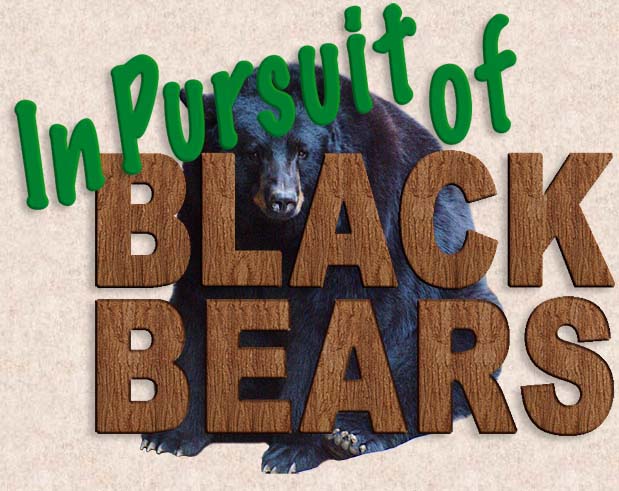
As I stated in Black Bears, Icons of the Mountain Forest, my prior knowledge of Black Bears was quite limited. Here in the 21st century, we're no longer dealing with the same Black Bear that once dominated the wilderness lands of the eastern United States. When Mrs. Highlander and I set out to discover more about Black Bears, it brought us into a greater awareness of the challenges Black Bears face daily in their continual pursuit for survival.
The loss of Black Bear habitat, unlicensed trophy hunting, poaching, vehicle fatalities and garbage eating bears, have brought these beloved icons of the Blue Ridge Smoky Mountains to near extinction. These majestic beasts, who once roamed the mountains, hills, woodlands and prairies east of the Mississippi River are now confined to wilderness mountain regions in relatively modest numbers. Human population and encroachment have made these noble residents nothing more than a mere public amusement for the average America citizen. The majority of us fail to recognize the potential problems of the lost Black Bear population due to a lack of proper education and information.
For decades, the general American public considered a Black Bear sightings in these mountains as commonplace, no different than a causal trip to the zoo, having no personal concern for the welfare of these animals. Many assumed all was in order, that the wilderness zookeepers were handling any issues in the wilds.
It was tourist handouts, unregulated garbage disposal and more lost habitat that added the greater strain on life where bears were concerned. It is only natural for Black Bears to prefer to distance themselves from human population, yet where do you go when your habitat is lost? Do you forage in the forest, or look for other ready-made food sources you’d find available?
To the Native Americans, the Black Bear was a totem of strength, an image of a spirit guide, a resource whose hide, ceremonial headdress and claws were prized as symbols of supernatural power. They were also a source of protein, their hides were used as robes and bedding, their bones were used as tools and there was a variety of uses for their oil or grease. Yet they didn’t interfere with the bear’s natural order of existence in their world, a necessity within their living cycle. They new there was always more than enough room for everybody, both man and beast. That all began to change when the Europeans came, clearing land and hunting game for food and hides, this was the first phase of decline for the Black Bear species.
Folk hero’s and adventurous statesmen like Daniel Boone and Davy Crocket along with other legendary fellow America frontiersmen, were famous for their “bar’ hunting” exploits. In those early days, North American wilderness lands were still plentiful as were the bears. That began to change for the worse in the latter 19th century thru the early 20th century when all land was being bought up and exploited for its resources.
Even though the Black Bear was admired by the Native Americans; considered a commodity by trappers; and more a nuisance than benefit to the newly arrived pioneers, the Black Bear was in serious danger of losing all their respectability.
Then came the loggers, clearing vast lands of sellable lumber, leveling off forestlands from horizon to horizon. It has been estimated that 80% of the hardwood forest in the Southern Appalachian Mountains fell to the saw in latter 19th and early 20th century, with no concern for wildlife welfare or watershed erosion. There were no agencies at the time to protect wildlife and wilderness lands, just a drive for need and greed.
Seeing the uncontrolled devastation the lumber companies were creating, the U.S. Department of Agriculture began to buy up some of these wastelands during the early 1900’s in order to protect and preserve wildlife, watersheds and old growth forest. Out of this endeavor arose the National Forest and National Park Service, dedicated to preserving protected forests, natural wonders, wildlife, watersheds and to control the lumber harvesting of public owned land.
On June 15, 1934, the official boundary of the Great Smoky Mountains National Park was established with an official dedication ceremony performed by President Franklin D. Roosevelt at Newfound Gap on September 2,1940. The timely founding and establishing of the National Park and the immense surrounding National Forest of the Blue Ridge Mountains, put thousands of unemployed people to work in the Civilian Conservation Corps. They labored at reforesting the clear-cut mountainous wastelands to preserve and restore the precious watershed. They built roads, bridges and tunnels to access thru the mountainous wilderness for forestry service personnel and public accesss. They blazed and opened trails into and thru remote recesses of the National Forest. They constructed lookout towers for firewatchers and for the many tourists to enjoy in the newly established public parks and forestlands.
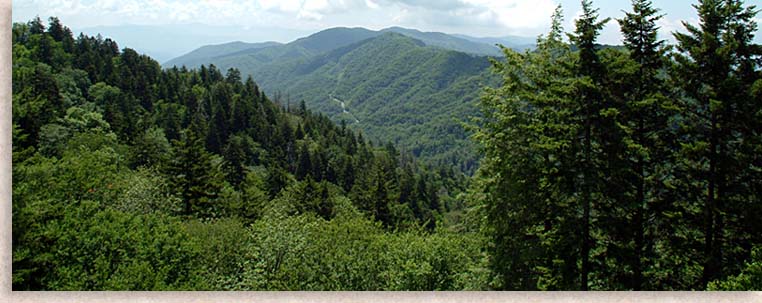
“Come and witness the beauty of the mountains, the giant trees of the old growth forest, the waterfalls, waterways, pioneer settlements, the native people along with the wonders of our nation’s wildlife.” All was great, all was good, millions upon millions of tourist herded into the newly forested mountain lands, looking for adventure and the natural beauty that laid within the national treasures of our own nation’s southeastern United States.
Everything was perfect, or so it seemed...until someone left the proverbial lid off the garbage can so to speak.
The problem was becoming obvious after decades of holiday visitors enjoying long lines of traffic within the Smoky Mountains National Park, mostly due to the numerous bear sightings along the Newfound Gap Road. Ready to meet and greet, Black Bears consisting of, papa bear, momma bear and cubby bears were hanging out at road side garbage cans, picnic areas, campgrounds, overlooks and general tourist hangouts. For the public the experience was fun and exciting, for the Black Bears it was destroying their natural wilderness way of life.
The park service was in charge of protecting its wildlife residents and supporting natural habitation for their woodland residence, all was fine in the backwoods of the forest. Although, it was at the public’s favorite sites, and the public becoming too comfortable with the wildlife, and it was the public that brought in the unnatural wildlife food and garbage resources that were causing a great deal of the problems.
To be honest, the public was just naive as well as negligent and generous too a fault with their treats and scraps. “Why can’t the friendly bears enjoy the same foods we enjoy, they sure seem to like it?" The problem was and still is, that the bears liked it so much that too many of the bears lost their natural fear of humans in exchange for scoring tasty handouts and tourist leftovers.
So unafraid of natural consequences, bears had no trouble climbing on picnic tables, on and in cars and trucks as well as climbing into campers, trailers and tents and even breaking into cabins unaware of they were committing felonies. All driven by an obsession for human related food, an obsession that seriously shortens and endangers the lives of habitual Black Bear.
In order for Black Bears to live full healthy lives, they must eat only what is natural to their diet. Bears will eat cans, glass, plastic, or wrappers, anything that has the sent of human food, they’ll even eat your compose pile. Not only are human foods dangerous to bears, the bear’s desire to obtain these foods have caused them to cross their natural wilderness barriers into the human realm where they are subjected to toxic poisons, and physical death due to consuming garbage, encountering poachers and vehicular homicide. Added to the problem are habitual mother bears that are foraging for their young cubs, knocking over garbage cans, opening dumpsters, panhandling tourist and running out into traffic, it’s not natural and its killing the bears and causing cubs to repeat the same offense because they don’t know any better. Bears, like humans have a hard time breaking bad habits, that’s why its our human responsibility that’s necessary to control the problem they unwittingly cause themselves.
The first to the bears rescue and defense was the National Forest Service’s Wildlife Agency, posting warnings not to 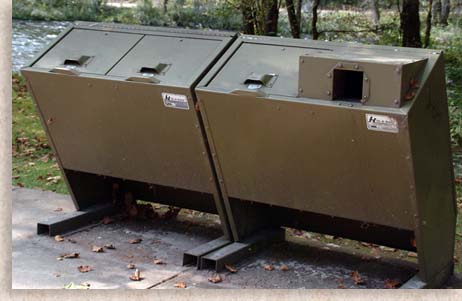 feed the bears by penalty of law. They also developed and replaced antiquated garbage cans along forestry roadsides, picnic areas and campgrounds with bear proof disposal containers, and the good news is they work. The first time I encounter one of these well-engineered trash containers, my higher primate intelligence at first let me down. To say the least I was monetarily challenged, but that’s me. I soon discovered the concealed lever just under the lid top, and disposed of my personal trash, not only was it more properly contained, it appears to be more sanitary and more visibly conducive to the natural surroundings.
feed the bears by penalty of law. They also developed and replaced antiquated garbage cans along forestry roadsides, picnic areas and campgrounds with bear proof disposal containers, and the good news is they work. The first time I encounter one of these well-engineered trash containers, my higher primate intelligence at first let me down. To say the least I was monetarily challenged, but that’s me. I soon discovered the concealed lever just under the lid top, and disposed of my personal trash, not only was it more properly contained, it appears to be more sanitary and more visibly conducive to the natural surroundings.
The, “let’s outsmart the dumb bear with a better bear proof can,” was no easy feat. Black Bears have similar motor skills of a curious toddler due to their great paw dexterity. The new "bear proof" trash containers work great, we humans can reach the lever because we can count on our fingers and some of us higher primates can even play instruments while bears can’t do either. No more capsized trashcans with litter strewn about the ground or bear-mauled trashcans with missing lids defacing our public highways and parklands.
The days of long lines of traffic through bear country are now a thing of the past, no more bears lining the roadsides like holiday concessionaires looking to trade a big bear smile and a photo opportunity for candy bars or other various treats. The National Forest Service has successfully done their job within the public owned lands with trash disposal and prohibited bear feeding postings.
The problem now sets within private own lands where trash cans, dumpsters and garbage dumps are still accessible to the bears. Some private citizens and companies have complied, especially around the Great Smoky Mountains and some other heavy tourist traveled areas in the Blue Ridge Mountains. But it is essentially necessary for everyone living in bear country to also comply to end the "bear eating garbage" problem along with other human created food sources such as bird feeders which need to be hung properly, pet food needs to be stored properly and bowls placed up at night. Used grilled grades need cleaning after every use and all composting needs to be secure from bear access. An article on Bear Safety is featured within this Blue Ridge Highlander series, Black Bears in the Blue Ridge Smoky Mountains.
I’m sure today, many visitors to the Blue Ridge Smoky Mountains miss the old days of all the easy experienced bear sightings throughout the National Park, State Parks and National Forest. It was exciting to see these big furry bears hanging out at popular spots, like family members joining together at a family and friend’s picnic. Those days are thankfully gone, and we’re richer in spirit for it, making individual efforts to preserve these original “Kings of the Mountains” for prosperity is well worth it and priceless to be assured. The hardest and most challenging times are behind us, though we’re far from out of the woods when it comes to the bear/human conflict.
It’s often good and sometimes even funny to see that people, both local and visitors still get excited when they see a bear or think they saw a bear. Mrs. Highlander and I were once standing along an overlook above a deep narrow gorge with a large cascading waterfall to our left side. We noticed a couple standing close by talking to other people. This couple thought they saw a big Black Bear standing in one of the waterfall’s cascades. A crowd began to gather, traffic along the road stopped, there was no rail between the narrow gorge overlook and the road, and definitely not enough room for everyone who was crowding, pointing and all excited. I went back to our vehicle and got my binoculars out to get a closer look at the phantom bear and to see what the bear might be doing. Much to my dismay, it wasn’t a Black Bear; it was nothing more than a large black rock sticking out of the water on a more level spot along the cascading waterfall.
I reported the unfortunate news to the onlookers; they were very disappointed and fortunately they didn’t push me over the ledge. Even though all these grown up folks had seen a Black Bear before, most likely at some exhibit locally or at a zoo back home, it was fun to see how excited they were thinking they saw a wild bear and even funnier how many of us humans they pulled into their illusion. That’s the impact and importance Black Bears have in our life, our nation and our hearts.
The Elusive Black BearToday, seeing Black Bears in the wilderness is a happenstance experience. Researching information about Black Bears is fairly easy compared to photographing bears in the wild.
Mrs. Highlander and I have witnessed several wild black bears in the Blue Ridge, Smoky Mountain region over the last 15 years. Achieving great bear photos is difficult to say the least. No longer accustomed to panhandling in trade for goodies and photo opportunities, has returned the majority of Black Bears to their natural habitats and naturally skeptical of humans. Most of our personal encounters have been in the National Forest and Parklands of Tennessee, North Carolina and North Georgia. These sightings consisted of bears crossing the road in a hurry to reach the other side; getting startled and running away and climbing rock walls or trees to avoid contact. We’ve seen cubs in the wild which most often means mom’s nearby, closing in for a photo can put you in direct contact with the cub’s overly protective mother. Considering her 300+ pound robust figure and 30-mile per hour charge, the thought of being mauled, damaging my camera or having to witness Mrs. Highlander physically fend off mama bear just so I could get a couple of good shots, wasn’t worth it, besides I believe in protecting the little ones and respecting mother’s space, the forest is their house and we’re just visiting.
The forest and thickets obscure a good many clear photo shots of Black Bears and then there were those times I foolishly didn’t have a camera with me. A few years ago we had this small car with a roof that popped off over the driver and front passenger side of the car, we hadn’t plan on taking a drive and found ourselves on the Chilhowee Mountain which over shadows Lake Ocoee between the Ocoee River Gorge to the east and the Tennessee River Valley to the west. We were on the descent along the paved mountain road with tall trees and a drop off to the left, with sparce trees and rock walls to the right. Coming around one tight curve we had to come to a full stop in order to avoid a Black Bear that was standing on the yellow line. Being startled, the bear headed towards the left edge of the road and stopped not wanting to take on the steep drop off, then doubled back in front of the car and headed towards the rock wall on our right side. He or she climbed paw over paw up about 15 feet before stopping and looking back over his or her shoulder grunting. We pulled about 8 feet forward and stopped right under the bear, who looked stuck at that spot. We were stuck also, stuck without a camera because we hadn’t planed on going for a drive. With the roof popped off, and since there was a T-bar for safety within the car’s roof, we joked about the bear slipping or climbing back down onto the car, luckily she/he just begrudgingly continued up the rock wall as small rocks began to tumble down. We pulled away so the bear could calmly climb up or down. Later we realized had we had our camera we might have been too tempted by the opportunity and put all three of us in danger by taking time for photos. It was more of an opportunity for human/bear/rockslide conflict.
Today you mostly hear about bear sighting experiences from others, yet it’s possible to see wild Black Bears casually traveling about the wilderness. Plenty of bears are in the forest, yet it’s the Black Bear’s natural preference to be solitary and it’s their keen sense of smell that helps the bears remain mostly undetected.
Some of my photo shots of Black Bears look like a large mass of black fur 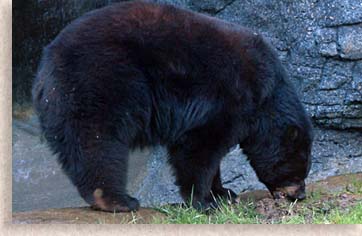 with a head sticking out on one end, most of the time the bear’s heads were either down or buried in the brush foraging for food. There was nothing stately or noble about these particular shots, just a ball of fur with some tree limbs blocking the picture. Some of the shots resembled big black furry hogs rooting around, reminding me that mother bears are called “sows,” an ironic though fitting term.
with a head sticking out on one end, most of the time the bear’s heads were either down or buried in the brush foraging for food. There was nothing stately or noble about these particular shots, just a ball of fur with some tree limbs blocking the picture. Some of the shots resembled big black furry hogs rooting around, reminding me that mother bears are called “sows,” an ironic though fitting term.
Campers who are spending a lot of time camped out in the deep forest in their tent; camper or RV’s, still have bear sighting fairly commonly. If you visit a bears great outdoor home for 24-hours a day, for several days, your likely to see one. I assure you the bear’s keen senses can smell campers from long distances; they either stay away or move in close drawn by cookout fires.
Mrs. Highlander and I could have camped out in the backcountry of the Smoky Blue Ridge Mountains in search of the elusive wild Black Bear. We could have gained advice from forest rangers as to where there had been recent sightings of bears. This might have produce some good pictures given the right amount of time for our bear-stalking mission. We could have followed the bear signs we picked up along the trail, such as claw marks on trees, footprints along a dew or rain soaked trail, maybe a thicket of fresh berries would draw a bear out into the open. Or possibly, we could have examined any dry bear stool we found along the trail for freshness and time of delivery, “yeah, right!”
After some unsuccessful and time limited treks into the forest, Mrs. Highlander and I decided to move on from the most obvious search location and move to the more comfortable possibilities towards finding Black Bears…we went to town. We visited several private zoos within a three-hour drive of our studio. Though some of the facilities we visited were well maintained, the atmosphere wasn’t always quite conducive for the type of photos we needed. Grandfather Mountain has a great wildlife exhibit as well as some others.
Unfortunately, during our visits to some private zoos we experienced some overall poor exhibits and absolutely appalling conditions; our hearts went out for those captives. I think some of the bears would have rather taken their chances with the hunters in the wildernes and skip the delivered meals. To be fair, some bears living in captivity aren’t physically capable of living in the wild due to life long captivity or some form of debilitating physical injury or serious health concerns.
In our many explorations in search of the Black Bears, one zoo we visited in the Great Smoky Mountains region has one of the most outstanding Black Bears exhibits I’ve ever seen, Black Bear Falls at the Knoxville Zoo in Tennessee. It is about an hour or less drive depending on traffic from the Great Smoky Mountains National Park.
The Symbolic Black Bear
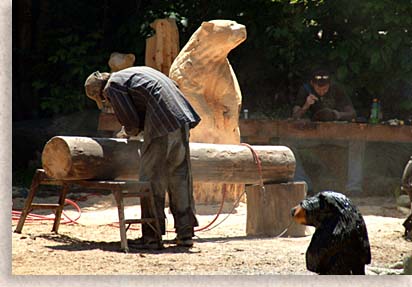 What we became more aware of along our photo bear hunt, were the many and various representation of Black Bear images, icons, statues, logos, signs, billboards, paintings, tapestries, carving, figurines, trolley cars and more. The Black Bears that once roamed the land that these towns now occupy, are still residing in the town in the form of artworks, gift items and other expressions. Not only are Black Bear symbols all over some towns just outside of the national parklands and forest, some of the towns have various types of live bear exhibits, some good, some not so good. So as you can see the bears altogether have never vacated these mountain tourist communities, their presence is ever predominate.
What we became more aware of along our photo bear hunt, were the many and various representation of Black Bear images, icons, statues, logos, signs, billboards, paintings, tapestries, carving, figurines, trolley cars and more. The Black Bears that once roamed the land that these towns now occupy, are still residing in the town in the form of artworks, gift items and other expressions. Not only are Black Bear symbols all over some towns just outside of the national parklands and forest, some of the towns have various types of live bear exhibits, some good, some not so good. So as you can see the bears altogether have never vacated these mountain tourist communities, their presence is ever predominate.
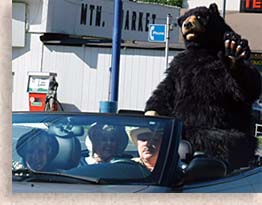 Together, Gatlinburg and Pigeon Forge have long established the Black Bear as an icon and mascot in Sevier County, Tennessee. These symbolic bears can be seen just about everywhere throughout these two popular Great Smoky Mountains tourist destinations. Beware though, there are some Black Bears roaming the streets of Gatlinburg and Pigeon Forge, shuffling on street corners doing a little bear dancing or riding around in cars waving at passers-by. They may be real bears or costumed bears, either way do not feed them and definitely don’t give them any money, it will only encourage them to show off even more.
Together, Gatlinburg and Pigeon Forge have long established the Black Bear as an icon and mascot in Sevier County, Tennessee. These symbolic bears can be seen just about everywhere throughout these two popular Great Smoky Mountains tourist destinations. Beware though, there are some Black Bears roaming the streets of Gatlinburg and Pigeon Forge, shuffling on street corners doing a little bear dancing or riding around in cars waving at passers-by. They may be real bears or costumed bears, either way do not feed them and definitely don’t give them any money, it will only encourage them to show off even more.
Two other towns we either visited in pursuit of the Black Bear or just so happen to be visiting on another Highlander mission have adopted the symbolic bears as their own also. These two town revivals are setting a firm claim of their own for Black Bear mania, Hendersonville in Henderson County North Carolina and the town of Cherokee on the Qualla Boundary in Swain County North Carolina.
Roaming on either side of Main Street in Hendersonville are bears of an artistic flavor, sporting trendy fashion styles and personal lifestyle expressions while mingling with shoppers along the thoroughfare of commerce in downtown Hendersonville. Historic Hendersonville is a beautiful and most accommodating setting and atmosphere for such an expression of artistic individuality considering the town/city of Hendersonville is seated against a backdrop of the Blue Ridge Mountains.
Here in Hendersonville its as though the bear race has joined the human race by assimilating our styles and customs, becoming capitalists, consumers, living the leisure life, finally moving out of those dark gloomy woods and taking to the streets. Leaving the “old timer bears’ to the forest while they personally choose to live the good life together with the city dwellers, going metro, laughing, loving, working and playing.
I think that’s what this mission of the Highlander’s discovery was all about, how the bears should live. One day we go into the forest and the bears follow us out of the forest. Then for the sake of their lives, we send the bears back into the forest where they belong. It’s a great gesture of camaraderie for the bears to want to join us. Just think if things would have worked out the first time; man living with bear…bear living with man…all together in peace and harmony. Then man living with ape, and ape living together with… hay wait a minute! That movie didn’t work out so well. ”Bears! Back into the Woods.”
The artistic bears in downtown Hendersonville really do brighten up the walkways, an outdoor art gallery with beautiful works entitled, The Painted Bears. An open-roofed street art museum whose cathedral sky is supported by columns of historic landmark buildings lining Main Street. It was a pleasure visiting and viewing each and every bear art exhibit in the downtown’s shopping district.
While strolling and admiring the bear population on Main Street, Mrs. Highlander and I also checked out many of the unique shops, galleries and restaurants. Hendersonville’s historic downtown setting embraces Main Street with a creative and very enjoyable atmosphere in a distinctive style for this mountain community. These bears are a welcome sight and a joy to have around, and since they don’t move around a lot or panhandle for goodies, they make excellent neighbors and citizens.
In our pursuit of the Black Bear, Mrs. Highlander and I spent a lot of time in, or crossing the Great Smoky Mountains National Park. Recently there has been talk about a lot of bears roaming along the Oconaluftee River where it flows through the town of Cherokee. Most of the bear sightings have been consistently along US Highway 411 north that runs through the heart of the town of Cherokee.
These are not transit or migrating bears being reported, but enormous Black Bear icons that are here to stay, kinder spirits of the Cherokee people depicted in metal, paint and artistic design.
This new addition to the town of Cherokee really brings the Black Bear home amongst the people who truly revered the natural “Kings of the Mountains.” Black Bears and the sacred “White” Black Bear are a significant part of the native Cherokee heritage. These new bears appear larger than life, moving along with a firm confident gate, taking charge of their new domain, reflecting the way it was, the way it should have always been.
Each bear statue is a work of art, painted by a chosen artist containing designs and murals that convey the lives of the Cherokee Clans, lives that existed in history both now and then, depicting symbols and renderings of their customs and achievements. With these new bear arrivals, the Cherokee and the Black Bear have once again united as one spirit in their mountain homelands.
The bear artworks are properly entitled by a subject and characterization. An engraved river stone placed at the bear’s feet is engraved with a title in both English and Cherokee along with the name of each artist. With creative art titles like, Eagle Dance Bear, Pottery Bear, Fair Bear, Cherokee Sunset and Bear on the Little Tennessee River to name a few of the dozen or so sculptures on display, each bear takes on a life all their own. One of the beautifully painted bears depicts an American flag and images of the Cherokee’s patriot heroes of foreign wars. The bears are becoming very popular with the tourist, and visitors to the town of Cherokee, we saw many visitors posing with the still bears while another visitor takes their picture, this is a much safer photo opportunity than with wild bears.
The bear statues themselves are large, about the size of a full grown grizzly, more like the 1,500 lb. bears of the Northwest than the 300 to 400 lb, Black Bears of the Smoky Blue Ridge Mountains. The bear’s sizes are perfect for the community’s landscape. Their strong and dominating presence assures their place within the town of Cherokee and its people, once again adjoined together in art and in spirit.
Mrs. Highlander and I have our own personal favorite bears, we both agree the Black Bear representing Sequoyah, creator of the Cherokee alphabet known as the Sequoyah Syllabeary is our combined favorite. This particular art bear supports Sequoyah’s signature turban on his head and long stemmed pipe hanging out of his mouth or jaw as bears go, this art bear has a great character independent of all the other bears. This isn’t to say we personally condone inanimate oversized Black Bears smoking, or that we think Black Bears should wear turbans in the woods, the branches would knock them off and get them all dirty, but wearing a turban in town is fine, and we’ll just pretend the pipe is for bubbles.
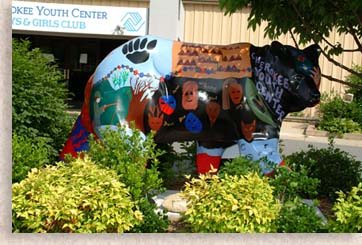 Several of the painted bears are located just outside the Cherokee Museum while others are appropriately place along the main thoroughfare and river. We did locate one bear hiding under a tree outside the Cherokee Youth Center, I believe the young artists at the center painted this shy bear that resides under the shade tree.
Several of the painted bears are located just outside the Cherokee Museum while others are appropriately place along the main thoroughfare and river. We did locate one bear hiding under a tree outside the Cherokee Youth Center, I believe the young artists at the center painted this shy bear that resides under the shade tree.
We always enjoy our visits to the town of Cherokee, being a tribal reservation or Native American Boundary, has made the town of Cherokee a one of a kind mountain town. Every time we go there we find or learn something new. As we were leaving town, we spotted an old bear friend of ours, and yours, at his post, doing his difficult work, obsessed with a concerned purpose that helps all our interest, Smokey the Bear.
What a beloved icon this bear has been to our nation, never faltering, decade after decade, a guardian of the forest, a protector of 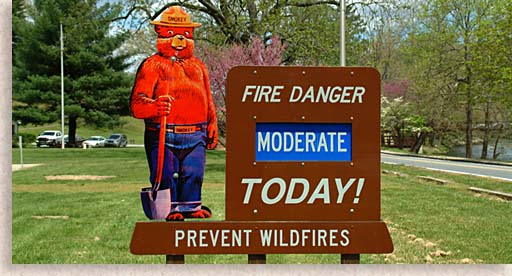 wildlife and a friend to the people. When you think about the National Parks and Forest of the United States, from sea to shining sea, you can’t help but remember Smokey the Bear. Created in 1944, this bear logo icon of the forest has had the longest running public service campaign in US history, strongly reminding us, “Only you can prevent forest fires.”
wildlife and a friend to the people. When you think about the National Parks and Forest of the United States, from sea to shining sea, you can’t help but remember Smokey the Bear. Created in 1944, this bear logo icon of the forest has had the longest running public service campaign in US history, strongly reminding us, “Only you can prevent forest fires.”
So in love with the image of the bear, we have made him the most dominating symbol of our forest and wilderness lands, and rightfully so, they are the “Kings of the Mountains.” The Blue Ridge Highlander has more to share with our friend Smokey the Bear in its upcoming feature story, “Only You Can Prevent Forest Fires!”
Black Bears and Those who Love Them
Today, with the “proverbial lid” tightly attached to the forestry garbage can, Black Bear sighting are becoming even more rare, and thank God for that, garbage and habitual bears are destined for short lives. Don’t entertain the thought of baiting Black Bears with food for fun or sport; it’s illegal, dangerous and cruel to the wildlife.
That’s why when seeking bears while visiting these mountain wilderness, it best to visit a proper, well cared for Black Bear habitat exhibit or wildlife sanctuary, its safer, easier and more assured. Although I do recommend keeping a camera close by for that happenstance Black Bear encounter in the wild, or along the roadway, you never know when that elusive bear just might appear.
Today, visitors to these mountains and newly arrived residents still long to see a bear in the wild, some even get the actual privilege. Old timers, whose families have lived here for generations could care less, they’ve seen them, they’ve hunted them and they’ve ate them during hard times, their attitude is understandable, “ya seen one bar’ ya seen em all.”
Yet there are some folks that have enjoyed long and short-term love affairs with wild and captive Black Bears that are legendary here in the Blue Ridge Smoky Mountains. Their personal need to understand, preserve, protect and enjoy a personal relationship with local and captive Black Bears are comparable to our affections for our own household pets.
Black Bears of the 21st Century
The plight of the Black Bear is a concern for all whether it’s the animal kingdom or its counter part, the human hierarchy. The problems that Black Bears are experiencing is directly associated to human encroachments. The Black Bear population in these mountains has moved from the endangered lists to the declining lists, this is due to controlled hunting, less vehicle/bear road fatalities (though that, like deer is a serious problem) along with other types of injuries that came with the consumption of unnatural foods and the worst is poachers who prey on them.
The public’s general love for Black Bears has welcomed them into our lives, as a symbolic mascot of what is cute, cuddly and adorable, often forsaking the fact that these are wild animals. The idea that we can imprint our human habits and even train bears as performers has created a sense of carelessness towards the Black Bear’s natural lifestyle. Before the opening of the Great Smoky Mountains National Park, rural folks considered wild bears to be ferocious and better left to their own ways. They considered the only things bears were good for, were their hides, oils and meat substance. Yet with the opening of the National Parks and Forest to preserve woodlands and it’s population and to accommodate public recreation, the Black Bear suddenly became our “friends of the forest,” and we forgot the nature of the bear’s ancestral origins as a wild animal.
Before the creation of the Great Smoky Mountains National Park the Black Bear was approaching its greatest threat of extinction due to logging when as much as two-thirds of what is now a national park fell to the cutting saw by private contractors. It is estimated that by 1939, there were only between 50 to 200 bears in the Smoky Mountains, at the time this article was written there were an estimated 1,500 in the park alone. The founding of the park was to preserve both nature and wildlife from further harm. The Black Bear made a triumphant comeback under the national park and wildlife programs, including no hunting within the park, only for the bears to have to face another danger, the danger of too much exposure.
By the late 1940’s the Great Smoky Mountains National Park became the most visited national park in the United States, exposing the wilds to millions of visitors. Today, the Great Smoky Mountains National Park sees 8 to 10 million visitors a year; the impact is heavy though visitors find the park totally enjoyable and rewarding. With the park’s popularity the Black Bear has personally become the icon of the park itself, our affections for the Black Bears have given new rise to the bears natural existence.
During the early 1940’s, longtime and devoted park naturalist, Arthur Tupka wrote from personal observation that, “As long as we have bears in this park there will be certain risks and problems that go hand-in-hand with these animals. We cannot have one without the other. In my opinion, our bears will always be worth these risks and these problems.”
The ultimate responsibility for the bear’s welfare is on our shoulders as a nation, we inherited the land and their big bear bodies in the process. It’s a responsibility we cannot take lightly. Left alone bears contend for themselves, its our encroachment has that placed us in a state of personal accountability. We can all do our share, little or as much as that may be. By always following proper Black Bear etiquette and obeying bear safety guidelines, we can do our part and succeed.
Licensed hunters are allowed to hunt bears annually in the National Forest, but not in the National Parks. Though the season is short; hunters should check with local Forest Services for license information and specific seasons. Bows, primitive weapons and rifles are allowed during separate seasons. Trapping is altogether illegal. Cruel as it may seem to some, legally hunting bears in season is necessary in order to control the population. Sportsmen do it for the skins and trophy mounting. It’s the poachers who are unacceptable and unwanted; they kill bears for the value of their gall bladders and paws alone. Poachers often use federally protect wilderness areas as hunting grounds which is highly prohibited.
Doing our part helps reduce the decline of Black Bears, yet who’s going to help those bears in need, like injured bears, or privately own bears abused at the hands of their uncaring owners. Then there are the abandoned cubs, whose mothers are often killed due to irresponsible hunters, poachers and unforeseen fatal injuries. All these matters concerning injured bears, injured bear cubs and abandoned cubs falls on the shoulders of caring individuals, organizations and the wildlife agencies, all of which are undermanned and under financed.
Some injured and abused Black Bears may find their way into the hands of individuals or organization that care, by the means of other people sighting an injured bear and informing the wildlife agencies. Should you see an injured bear, always alert the authorities. Make no attempt to help an injured bear on your own; injured bears can be even more dangerous. Abused or neglected bears, in someone’s personal private zoos might get lucky if someone will report the abuse to the proper agencies. They might find their way to proper treatment, shelter, food and health care. Sometimes the abuser tires of the bears and just wants to get rid of them, sadly enough, most abused bears just die in captivity.
These types of bears can never be returned to the wild, because they’re not fit to survive on their own. Bears in some private zoos live dismal lives due to improper habitat and care while others can live rather enjoyable lives, properly fed and sheltered, they seem to thrive on personal human attention, and that’s good under their circumstance, considering bears are normally solitary creatures.
Lost Habitat and Bear/Human Conflict, Where does a Black Bear Go?
As I have stated, Black Bears are solitary animals though male bears will occasionally bond with other male bears throughout the year, while females avoid other bears except during mating season, only preferring the company of their own species during those mating times. Female bears don’t get along with other female bears in the wild due to conflict in foraging territories, and adult male bears can’t be trusted and will eat a mother’s cubs if left alone.
When it comes to bears overpopulating certain wilderness areas and habitual bears not wanting to leave human populated areas, relocation might be the only thing available, yet it is a last result to take. Wildlife officials can try to drive a problem bear away, but it will likely be back when it gets hungry again. If they move a bear into the wilderness, the bear chances violent encounters with other bears over territory. Plus full-grown Black Bears unlike, newly released yearlings, most always try to find their way back to their familiar home habitats where they grew up. In doing so, many face uncertain dangers trying to return, often getting hit by road vehicles in their attempt to find home or they startle local residents who may over react.
Most often the wildlife agents try to narrow down the problem, which is usually caused by human food disposal. Wildlife agents and rangers encourage residents and visiting guests to practice bear safety and proper food containment and disposal before they chose any bear relocation.
Thanks to the U.S. Wildlife Agencies, loving caretakers and good private zoos, along with those committed to educating the public about Black Bears and their lifestyles in the wilderness, there is hope for the Black Bear future. It is these concerned folks who continue to lead the way and build better relations between bears and humans. We humans can only get in the way of what was once natural to the Black Bears and their own homelands, our involvement must be specialized at this point to secure our nation’s bear destiny. So much has been taken from them and there’s only so much left for them to enjoy. They need their space and solitude to be who they were meant to the be, “Kings of the Mountains.”
To know more about the general characteristics and natural lives of the Black Bear, turn to our Blue Ridge Highlander’s “Characteristics of the Black Bear,” within our Black Bears of the Blue Ridge Smoky Mountain's section.
The Highlander
Read our other Tales within the Black Bears of the Blue Ridge Smoky Mountains
![]()
Sign
up for the Blue Ridge Highlander Newsletter, Messages from the Mountains
to find out first about our new feature stories, road trips and special offers
Your e-mail addresses will not be sold or given away to anyone.
Privacy
Policy
Interested in your business being on the Highlander, click here...
Let our visitors tell you about the Highlander...
Click the feathers to go to the Highlander site
map...

